How Pirelli made Moto2 faster and why it has no plans for MotoGP… for now
Moto2 lap and race records are broken most weekends by Pirelli, but there’s still more to come, say the championship’s top chassis constructors. Plus, will the Italian company bid to become MotoGP’s sole tyre supplier from 2027?
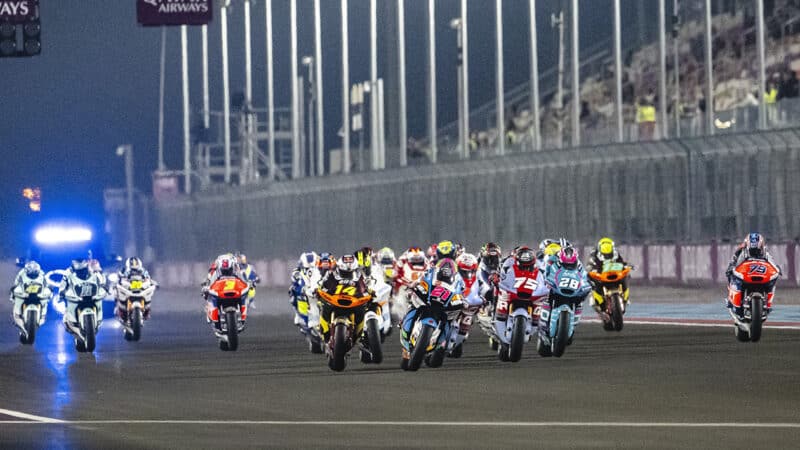
The season-opening Qatar Moto2 race was slower than last year’s because teams and riders were still adapting to the Pirellis. Every comparable race since COTA in April has been faster
Moto2 is faster than ever this year. Why? Because Pirelli has taken over from Dunlop as tyre suppler to the intermediate grand prix class.
The last five comparable Moto2 races (COTA, Jerez, Barcelona, Assen and Sachsenring) were an average 13.6 seconds faster than last year, a difference of around half a second per lap.
How has this happened – is it Pirelli’s front or rear slicks that are making the difference?
“The front tyre has improved a lot,” says current Moto2 points leader and Boscoscuro rider Sergio Garcia.
“My feeling is that the better lap times come from the front tyre,” agrees Kalex rider Ai Ogura, who is Garcia’s closest challenger. “At some circuits, maybe even some corners, the Dunlops are better, otherwise the Pirellis are better. Both rear tyres are more or less on the same level, but the Pirelli front is a step ahead.”
Of course, some riders are finding the going more difficult with the Pirellis, although this may be a case of adapting bike set-up and riding technique.
“It’s funny how some people are struggling on the Pirellis, because I can’t see how that’s a possibility,” says third-overall Joe Roberts (Kalex). “I always need that last bit of feel entering the corner with the brake. I never quite had that with the old tyres – the front didn’t have much grip, so the rear always pushed the front too much, so I never had the turning I liked, whereas with the Pirellis it all feels connected. More front grip has really made the difference for me.”
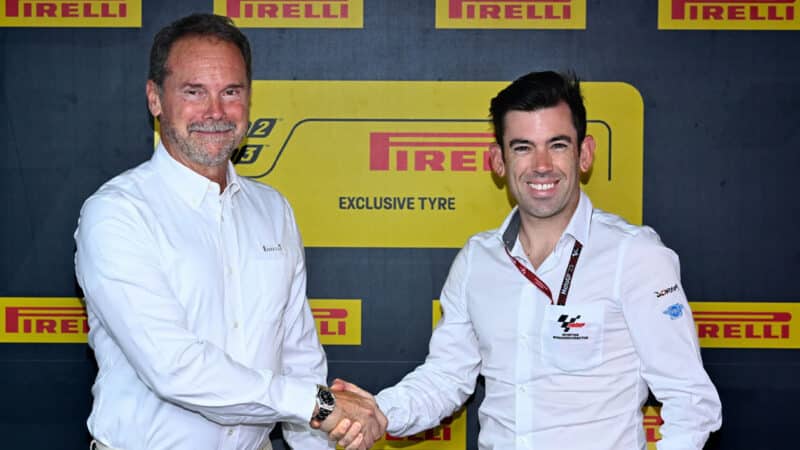
Pirelli director of motorcycle racing Giorgio Barbier and Dorna chief sporting officer Carlos Ezpeleta
Dorna
Moto2’s top engineers agree with its top riders.
“We see a bit more entry speed and corner speed, also a bit more lean angle and also fewer crashes, which is a sign of improved front feeling – the riders are getting a bit more information,” says chief Kalex engineer Alex Baumgartel, designer of the chassis that won the last 22 Moto2 rider and constructor titles. “It’s still an exit-dominated lap time, more or less, but how you approach the corner is the key to having a good exit.”
“At almost every circuit the lap times and race times are faster, so the tyres are better,” adds Luca Boscoscuro, designer of the chassis that leads the current rider and constructor points chases. “The front gives the riders more feeling — with the Dunlop it was difficult to understand where the limit was.”
Why does the Pirelli front work better than the Dunlop? Because it’s a softer construction, so it deflects (squishes) more, which gives two benefits: the squish creates a fatter contact patch and the movement in the tyre gives more feedback to the rider – essentially an early warning system of impending doom.
The same is true comparing the Pirelli front to Michelin’s MotoGP front, also a stiffer tyre.
A few years ago MotoGP and World Superbike riders used to share Jerez for a few days at the end of each season.
“The Pirelli front deflects, so we can deflect the tyre and go in really hard,” six-times WSBK champ Jonathan Rea told me in 2020. “The MotoGP guys have to use a much larger radius into the corner, so they cover more metres getting to the apex, whereas we can pretty much point the bike straight at the apex.”
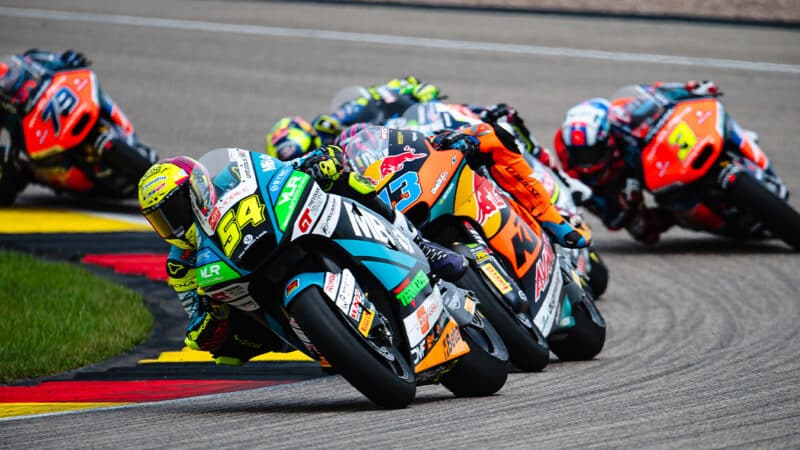
Aldeguer leads Celestino Vietti and the pack, including Garcia (3) and Ogura (79), at Sachsenring
Pirelli
Unlike Dunlop and Michelin, Pirelli bases its race tyres on its road tyres. This is a marketing and costs deal as much as anything, but not that surprising when you consider that the Italian company has been mostly involved in road-bike racing – Superbike and Supersport – for the last two decades or so.
Pirelli makes its race tyres – for WSBK, WSSP, Moto2 and so on – on the same machines as it makes its road tyres.
This partly explains the squidgy casings – visit a motorcycle dealership, grab a Pirelli tyre and you can twist the casing in your hands. You can only do this with Dunlops and Michelins once the casings have been heated to their operating temperature.
“This has always been our DNA,” says Giorgio Barbier, Pirelli’s director of motorcycle racing. “We started using car-tyre machines to build our motorcycle tyres, then we developed machinery just for our motorcycle tyres. The focus has always been to get feedback from the tyres, also because this is important for road tyres.”
Of course, it’s a fine line between just enough deflection and too much, which would make the tyre and the motorcycle unstable.
“Last season especially we worked a lot on the front in WSBK,” adds Barbier. “Because we want to give riders the feeling of stiffness, rigidity and precision of our hardest tyre, the SC2, with the grip of the softer SC1 in braking and entry. This is an incredibly difficult mixture, because riders need to trust in the front and because it’s also about feeling, which means it’s not only a matter of technology. To find something that every rider can appreciate is quite difficult.”
The process of moving from WSBK and WSSP to GP racing hasn’t been easy for Pirelli, especially considering Moto2’s front rim size of 3.75in, which is bigger than World Superbike’s 3.5in rim.
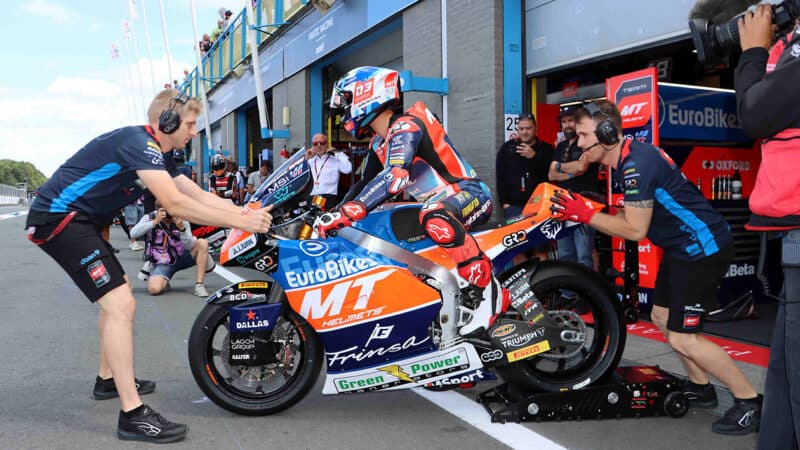
Garcia on his Boscoscuro at Assen
Oxley
“When we approached this championship the first question was which rim sizes should we use,” continues Barbier. “Looking at the power and weight of the bikes we thought our WSSP front would be the best solution, but then we found the 3.75in front rim, which was so strange to us. The front tyre we use in WSSP would not adapt to this rim, so we decided to use our bigger Superbike front.”
Moto2 has specified the same rim sizes since its inaugural 2010 season to reduce costs for the teams, most of which aren’t rich by any means.
“I was thinking this could be a problem for the handling – too-big rims and too-big tyres, but I was surprised the riders don’t feel it. Now we are talking to IRTA [the teams’ association] about using a 3.5in front rim [for 2025], because this will further improve front performance.”
Barbier acknowledges that its biggest focus for 2025 will be improving its rear slick, also a superbike tyre, which Moto2 bikes can’t fully exploit.
“The most important thing is to get the rear tyre working properly, because the bikes and riders aren’t heating the tyre enough. They are heating the front a lot, because they are pushing so much with the front and not so much with the rear. Sometimes they start with the tyre at the proper temperature and the tyre loses temperature during the race.”
Pirelli introduced a revised rear slick for the Sachsenring but it won’t be until 2025 that big changes will be made.
The switch from Dunlop to Pirelli has coincided with an apparent shift from Kalex to Boscoscuro domination. So far this year the score is seven victories to one in favour of the Italian constructor, whereas during the previous 11 seasons it was 168 to 10 in favour of the German constructor.
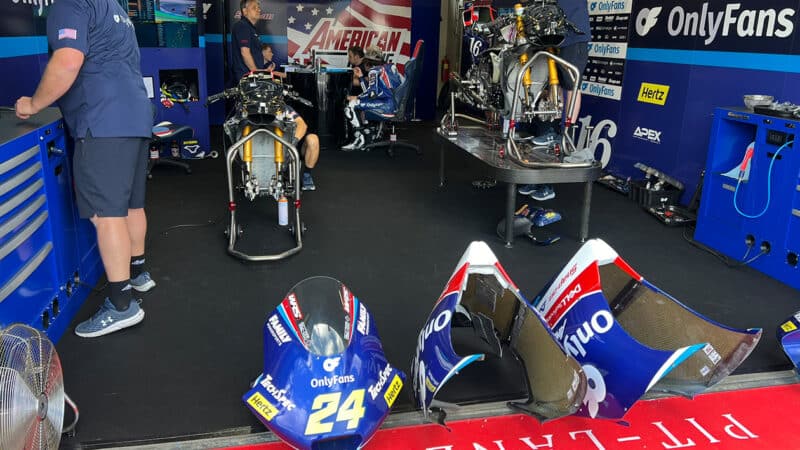
The Kalex machines of Marco Ramirez and Joe Roberts
Oxley
However, things may not be quite as they seem. Boscoscuro won the last four races of 2023, on Dunlops, with brilliant teenager Fermín Aldeguer. And Boscoscuro doesn’t think the Pirellis have boosted his chassis, quite the opposite in fact.
“We had more of an advantage with the Dunlops than with the Pirellis,” he says.
Of course, Moto2’s development ban means that whichever chassis currently works best with the Pirellis is largely meaningless, because engineers had to guesstimate their 2024 designs on the back of a few days of testing. Therefore 2025 will be the true test of which constructor gets the most grip out of the Pirellis.
“After these first eight races with Pirelli we are already working on next year’s chassis, which we plan to have on track for testing soon,” says Baumgartel. “We can only use non-contracted Moto2 riders for testing, which is a bit tricky because we will be missing the last second, so there will always be a question mark behind the test results.”
Contracted Moto2 riders will have their first chance to test the 2025 prototype chassis after the season-ending Valencia GP in mid-November.
Meanwhile teams are doing their best to adjust the current chassis to the Pirellis, after 14 years on Dunlops.
“Our set-up has changed but not so much, just a little balance and geometry – we are not so far away from the setting Aldeguer used to win races last year,” adds Boscoscuro.
“The balance of our bikes has changed but only slightly,” says Baumgartel. “We still see similar lap times with different set-ups, which shows there’s still work to do with bike balance and riding style. We are not yet in the sweet spot of set-up.”
Pirelli now dominates the world of top-level motorcycle racing like no other tyre company before. It is the sole tyre supplier to Moto2, Moto3, WSBK, WSSP, WSSP600, British Superbikes, the JuniorGP World Championship, Idemitsu Asia Talent Cup, Northern Talent Cup, Red Bull MotoGP Rookies Cup, FIM MiniGP World Series and Women’s Motorcycling World Championship.
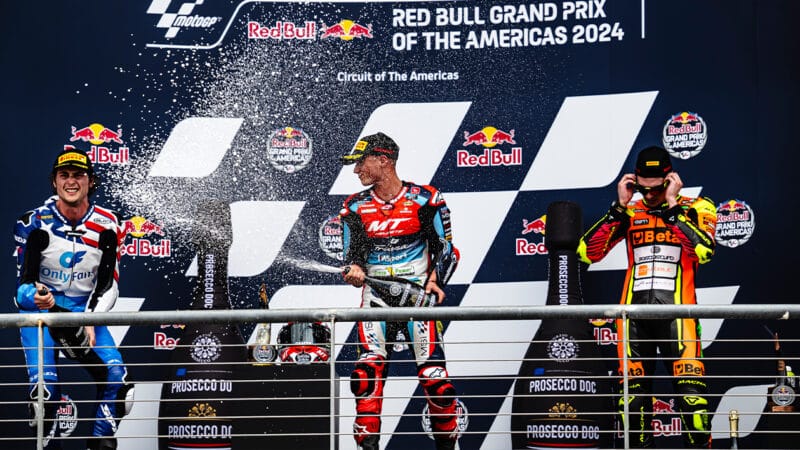
Roberts, Garcia and Aldeguer on the podium at COTA, where the race was 17 seconds faster than last year
Pirelli
Therefore the obvious question to Pirelli is this: will it bid to become MotoGP’s sole tyre supplier once Michelin’s current contract expires at the end of the 2026 season, even though the company has always insisted it will only race what it sells, in other words, no prototype tyres.
“When you have MotoGP bikes with carbon brakes the riders push so much in braking, which means using tyres that aren’t market tyres, because no one on the road will ever have all that braking power, so it’s not our DNA,” explains Barbier. “Maybe we will consider MotoGP but it would mean going far away from market tyres. And making prototype tyres for 24 bikes is another world.”
Pirelli achieved its first world-class success in the very early years of motorcycling’s world championships, when it won the 1950 500cc/MotoGP title with Gilera. The company returned to 500 GPs in 1988 and 1989, with the Cagiva factory and the independent Gallina Honda team, with rider Pierfrancesco Chili. In 1989 Pirelli won the World Superbike championship with Fred Merkel.
When Pirelli became WSBK’s sole tyre supplier in 2004 it started a process that took over motorcycle racing – the only major championship that retains open competition between different tyre manufacturers is the Endurance World Championship.

